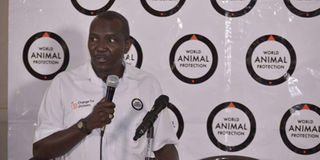Before you enjoy that chicken, think about its well-being, urges animal welfare group

Dr Victor Yamo, World Animal Protection's Humane and Sustainable Agriculture Campaigns Manager speaks during the launch of the 'Exposing the secret suffering of chickens farmed for meat' report. The report estimates that globally, about 60 billion broilers are raised for consumption annually. PHOTO | NATION MEDIA GROUP
What you need to know:
- The campaign is informed by a report which details the secret suffering of chicken farmed for meet.
- Good animal welfare requires appropriate shelter, nutrition, management, disease prevention, veterinary treatment, humane handling and slaughter.
- Chicken meat will make up most of this additional consumption hence without intervention to protect the chickens industrially farmed to meet this demand, their widespread suffering will also rise exponentially.
- In the farms with older birds, the chicken were crowded it was hard for them to move making it difficult for them to get to the food and water points.
GLOBAL ANIMAL welfare organisation, World Animal Protection has embarked on a global campaign to improve the lives of industrially-farmed chicken.
In the campaign, WAP is calling on global fast food chains to commit to not using cages to rear chickens for their meat.
The campaign is informed by a report which details the secret suffering of chicken farmed for meet.
The report, ‘Exposing the secret suffering of chickens farmed for meat’, gives first-hand accounts from WAP investigators who visited industrial farms in both European Union (EU) and non-EU countries.
While launching the report during the organisation’s monthly round table breakfast meeting at the Silver Springs Hotel in Nairobi, Dr Victor Yamo WAP’s Humane and Sustainable Agriculture Campaigns Manager said that animal welfare is defined by the World Organization of Animal Health (OIE) as how an animal is coping with the conditions in which it is living.
“This implies that an animal is said to be in a good state of welfare if it is healthy, comfortable, well nourished, safe, able to express innate behavior and is not suffering from unpleasant states such as pain, fear and distress,” said Dr Yamo.
Good animal welfare, he added, requires appropriate shelter, nutrition, management, disease prevention, veterinary treatment, humane handling and slaughter.
The report estimates that globally, about 60 billion meat chickens, popularly known as broilers, are raised for consumption annually.
Further, about 40 billion of them live in miserable, cramped and overcrowded conditions, typically going from hatchery to slaughter house in six weeks.
MASS PRODUCTION OF CHICKEN MEAT
The report estimates that the global average of meat a person will eat annually is expected to increase by 1.3kg by 2025, reaching 35.3kg per person.
Chicken meat will make up most of this additional consumption hence without intervention to protect the chickens industrially farmed to meet this demand, their widespread suffering will also rise exponentially.
The investigators visited both large and small industrial farms. Both were characterised by many chicken reared for around 40 days and then slaughtered.
Many of the chickens they saw were rapidly panting due to the heat. Some were lying on the ground, sometimes at an awkward angle with their feet stretched out.
Because broiler chickens are bred to gain as much weight as possible in the shortest time they become heavy and unable to move around easily.
In the farms with older birds, the chicken were crowded it was hard for them to move making it difficult for them to get to the food and water points.
The investigators learnt that to create space for birds that required more days to grow, the bigger birds are removed for slaughter from 30 days of age.
All farms had some sick, dying or dead birds. “One dying chick just lying on its back, belly up with its legs splayed out, taking short, sharp breaths and looking at the ceiling.
I filmed it for several minutes. It seemed as if it had decided not to fight any more, all of its energy had just seeped away,” noted the investigator.
Alarmingly, few consumers of chicken meat are aware of such suffering, which the report attributes to the mass production of chicken meat as demand for chicken meat continues to rise.





